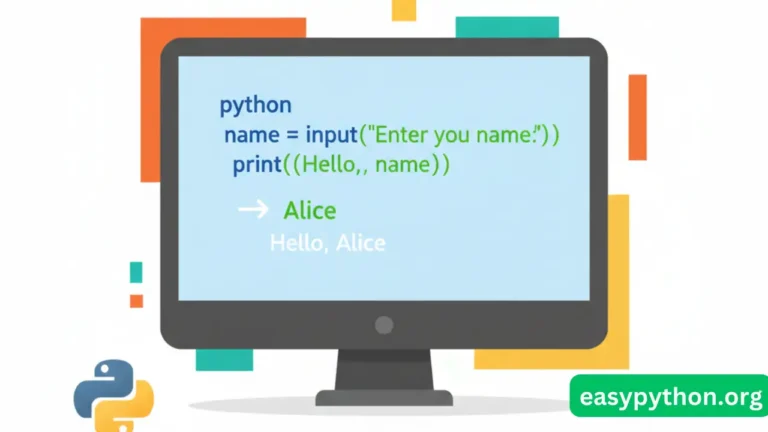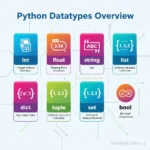Remember the first time you wrote print("Hello World")? You felt like a wizard… until you realized it was basically a one-way conversation. You talk, Python listens, but Python never replies. Like texting your crush and only getting “seen ✅” back.
That’s where user input comes in. Finally, your program doesn’t just shout things into the void — it asks you stuff and reacts.
It’s like giving Python a personality (okay, a boring personality, but still better than nothing).
Today, we’re going to master Python’s input() function — the secret sauce that makes your programs interactive, fun, and slightly less robotic. By the end of this guide, you’ll not only know how to get input from users, but also how to handle errors, validate entries, and avoid the classic “ValueError: invalid literal for int()” meltdown.
Buckle up
What is input() in Python?
In Python, input() is a built-in function that:
- Displays a prompt (optional message to the user)
- Waits for the user to type something
- Returns that input as a string
Example:
name = input("What’s your name? ")
print("Nice to meet you,", name)👉 Output:
What’s your name? Azeem
Nice to meet you, AzeemSee? For the first time, Python actually listens. Kinda wholesome, right?
Important: input() Always Returns a String
This is the #1 trap beginners fall into. Every. Single. Time.
age = input("Enter your age: ")
print(age + 5) # 💥 Error incoming!That’s right, Python doesn’t know your age is a number — it thinks it’s text. If you type 25, Python sees it as "25". Adding 5 to "25" is like adding sugar to Wi-Fi — doesn’t compute.
✅ The fix? Type conversion:
age = int(input("Enter your age: "))
print(age + 5)Now Python proudly calculates like a proper calculator.
For more on data types and conversions, check out this handy guide: Python Data Types Overview with Examples.
Handling User Input Like a Responsible Coder
If you’ve ever asked a user to “Enter a number” and they typed “banana”… you know the pain.
That’s why validation exists. Example:
try:
age = int(input("Enter your age: "))
print("Wow, you’ll be", age + 10, "in 10 years!")
except ValueError:
print("Bruh, that’s not a number 🤦")This way, your program won’t self-destruct if someone tries to type nonsense.
Getting Multiple Inputs in Python
Sometimes you want more than one piece of info at once. Python makes this easy with split().
x, y = input("Enter two numbers: ").split()
print("Sum:", int(x) + int(y))👉 Input: 5 10
👉 Output: Sum: 15
It’s like speed-dating, but for variables.
Best Practices for User Input
Here are some golden rules (trust me, they’ll save you):
- Always validate input (never trust the user — even if that user is you).
- Use clear prompts →
"Enter your age (numbers only): "is better than"Enter:". - Convert types immediately if you expect numbers, floats, etc.
- Loop until valid → Don’t let your program die on one bad entry.
Example:
while True:
try:
score = int(input("Enter your exam score: "))
break
except ValueError:
print("Please enter a valid number 🙏")Fun Fact: Python Used to Have raw_input()
If you’re using Python 2 (first of all, why tho?), you might see raw_input(). In Python 3, it’s just input(). End of story.
Real-Life Example: A Mini Quiz Game
Let’s build something fun with input.
print("Welcome to the Python Quiz!")
answer = input("What keyword is used to define a function in Python? ")
if answer.lower() == "def":
print("Correct! 🎉")
else:
print("Oops, the right answer is 'def'.")Boom — you just made a tiny interactive game. Want to take quizzes seriously? Maybe even add one to your site? You might like this resource: Python IDLE Tutorial (Step-by-Step).
Common Input Mistakes (And How to Avoid Them)
- Forgetting type conversion →
"25" + "5"="255"(not 30). - Assuming users follow instructions → They won’t. Always validate.
- Bad indentation in loops → Check out Python Indentation Rules with Examples to avoid rookie tears.
Expanding Beyond input()
While input() is great for small scripts, real-world apps use:
argparse→ For command-line arguments.click→ A fancy library for interactive CLI tools.- GUIs or web forms → When you’re done living in the terminal cave.
If you’re just starting out though, stick with input() and small scripts until you feel confident. (And if you’re still setting up Python, here’s your survival kit: Getting Started with Python).
📝 Python User Input Cheatsheet
| Task | Code Example | Notes |
|---|---|---|
| Basic input | name = input("Enter your name: ") | Always returns a string |
| Convert to int | age = int(input("Enter age: ")) | Use int() for numbers |
| Convert to float | price = float(input("Enter price: ")) | Handles decimals |
| Multiple inputs | x, y = input("Enter two numbers: ").split() | Separate with space |
| Convert multiple to int | x, y = map(int, input("Enter two numbers: ").split()) | Handy for math ops |
| Loop until valid | <pre>while True:\n try:\n num = int(input(“Enter a number: “))\n break\n except ValueError:\n print(“Try again!”)</pre> | Validation with try/except |
| Handle empty input | text = input("Enter text: ") or "Default" | Uses "Default" if left empty |
| Lowercase input | ans = input("Yes or No? ").lower() | Great for comparisons |
| Compare input | if ans == "yes": print("👍") | Normalize with .lower() |
FAQs About Python User Input
What type does input() return in Python?
Always a string. Convert it if you need numbers.
Can I get multiple inputs at once?
Yes, with .split() → x, y = input().split().
How do I handle bad input?
Use try/except and loops. Don’t trust users. Ever.
Why doesn’t input() work in some environments?
Some IDEs or online editors don’t support interactive input. Try Python IDLE for a beginner-friendly environment.
Final Thoughts
Learning Python user input is like learning how to finally have a two-way conversation with your code. It won’t suddenly become Chatbot-smart (trust me, I checked), but it’ll make your programs interactive, fun, and practical.
So go ahead — ask Python for a name, a number, or maybe even their Wi-Fi password (just kidding… unless? 👀).
And if you want to keep leveling up, don’t miss:
Because Python isn’t just about writing code. It’s about making your computer finally listen to you (and not just your mom yelling at you to shut it down at 2 AM).





[…] Taking user input […]
[…] This comes in handy when taking user input since all input is str by […]